Overview
This article highlights engaging activities designed to teach children the valuable skill of taking turns, particularly through the use of social stories. It underscores the significance of personalized narratives, interactive role-playing, and visual aids in helping children grasp the concepts of patience and social skills. By making learning about turn-taking relatable and effective, these strategies can be especially beneficial for youth, including those with autism and ADHD.
As parents, we understand the challenges you may face in this journey. Imagine your child, eager to join in but struggling to wait their turn. With the right tools and approaches, we can transform this experience into a positive learning opportunity. Consider incorporating personalized stories that resonate with your child's interests, or engaging in role-playing scenarios that allow them to practice turn-taking in a safe environment.
Visual aids can also play a crucial role in this learning process. They provide tangible examples that can make abstract concepts more concrete. By using these methods, we can foster a deeper understanding of patience and social interactions in our children.
We invite you to explore these strategies and share your experiences with us. How have you approached teaching turn-taking? Your insights could be invaluable to other parents navigating similar paths. Together, we can create a supportive community that empowers our children to thrive in their social skills.
Introduction
In a world where social interactions can be particularly challenging for children with autism and ADHD, innovative resources are emerging to bridge the gap in social skills development. ASD Media stands at the forefront of this movement, dedicated to empowering parents and professionals with effective strategies that foster confidence in navigating social situations. By emphasizing community support and collaboration, ASD Media not only enhances the therapeutic experience but also showcases the profound impact of structured learning through personalized storytelling, role-playing, and visual aids.
As recent studies reveal, the integration of these engaging methods transforms the learning process, making essential skills like patience and turn-taking more accessible and relatable for children. This article delves into the multifaceted approaches offered by ASD Media, exploring how these tools contribute to meaningful social development and ultimately enrich the lives of children facing these unique challenges. Together, let’s discover the resources that can make a difference, fostering a brighter path for our children.
About ASD Media: Comprehensive Resources for Social Skills Development
At ASD Media, we are devoted to promoting the application of ABA therapy, offering a wealth of resources designed to enhance the development of interpersonal abilities. Our mission is centered on empowering parents and professionals with effective strategies and insights, enabling individuals with autism and ADHD to navigate their interactions with confidence. By nurturing a supportive community, we facilitate the exchange of experiences and information, making our resources essential for those dedicated to improving interpersonal skills in youth.
Recent studies highlight the critical role of community support in ABA therapy, revealing that collaborative efforts among therapists, families, and individuals significantly improve therapeutic outcomes. It’s important to note that data shows an overall rate of missing information at 11.2% for analytic variables, which presents challenges in measuring outcomes effectively. Karen J Coleman, PhD, underscores this point, stating, "these findings suggest that even in a state context where there is mandated commercial insurance coverage for ABA, there are health system implementation challenges that may limit the extent to which interventions translate to meaningful patient outcomes."
Our case studies at ASD Media showcase successful strategies for social skills development, including the effectiveness of a taking turns social story that illustrates the positive impact of our resources. For instance, a longitudinal study tracked changes in adaptive behavior scores over time for children receiving ABA therapy, revealing that those who remained in ABA for 24 months exhibited modest improvements, particularly among those with lower initial scores.
As the field of ABA therapy continues to evolve, ASD Media is committed to staying at the forefront, providing timely insights and fostering an inclusive environment for growth and learning. We invite you to share your experiences and connect with our community, as together we can make a meaningful difference.
Waiting for My Turn: A Social Story Activity for Patience
The 'Waiting for My Turn' narrative is an excellent example of a taking turns social story that helps youngsters understand the concept of patience. This engaging activity involves reading a story that illustrates various scenarios where waiting is essential, such as waiting to play with a toy or to contribute in a group discussion. By incorporating the child's name and favorite activities into the narrative, it becomes more relatable and impactful, reinforcing the idea that waiting is a natural part of social interactions.
Research indicates that personalized narratives significantly enhance young people's educational outcomes, particularly in understanding patience. Role-playing activities further enrich this experience by allowing children to practice waiting scenarios in a safe environment, solidifying their grasp of the concept. Social narratives not only educate but also empower youth, transforming challenging interpersonal situations into manageable learning opportunities. As Kevin Henkes beautifully expresses, "Waiting is a gentle story about five toys sitting on a windowsill, waiting for different things," which captures the essence of patience in a relatable way.
The importance of patience in interpersonal interactions is especially crucial for youngsters with autism and ADHD. The taking turns social story provides a structured approach to teaching patience, making it an invaluable resource for parents and educators alike. Social stories aim to educate and empower young individuals, rather than control or monitor their behavior, highlighting their positive role in teaching patience. Expert opinions underscore the effectiveness of narrative techniques in promoting a taking turns social story and patience, highlighting their role in fostering positive interpersonal behaviors.
In a pertinent case study titled 'Unmasking the Differences: Autism vs. BPD,' insights were gained into the overlapping traits of autism and borderline personality disorder, underscoring the necessity for tailored management strategies. Such findings reinforce the significance of personalized methods, like narratives, in supporting youth's interpersonal growth.
To enhance the educational experience further, parents and educators are encouraged to create their own tailored narratives, weaving in specific scenarios and characters that resonate with the child. This practical application can greatly enrich a young person's understanding of patience and social interactions.
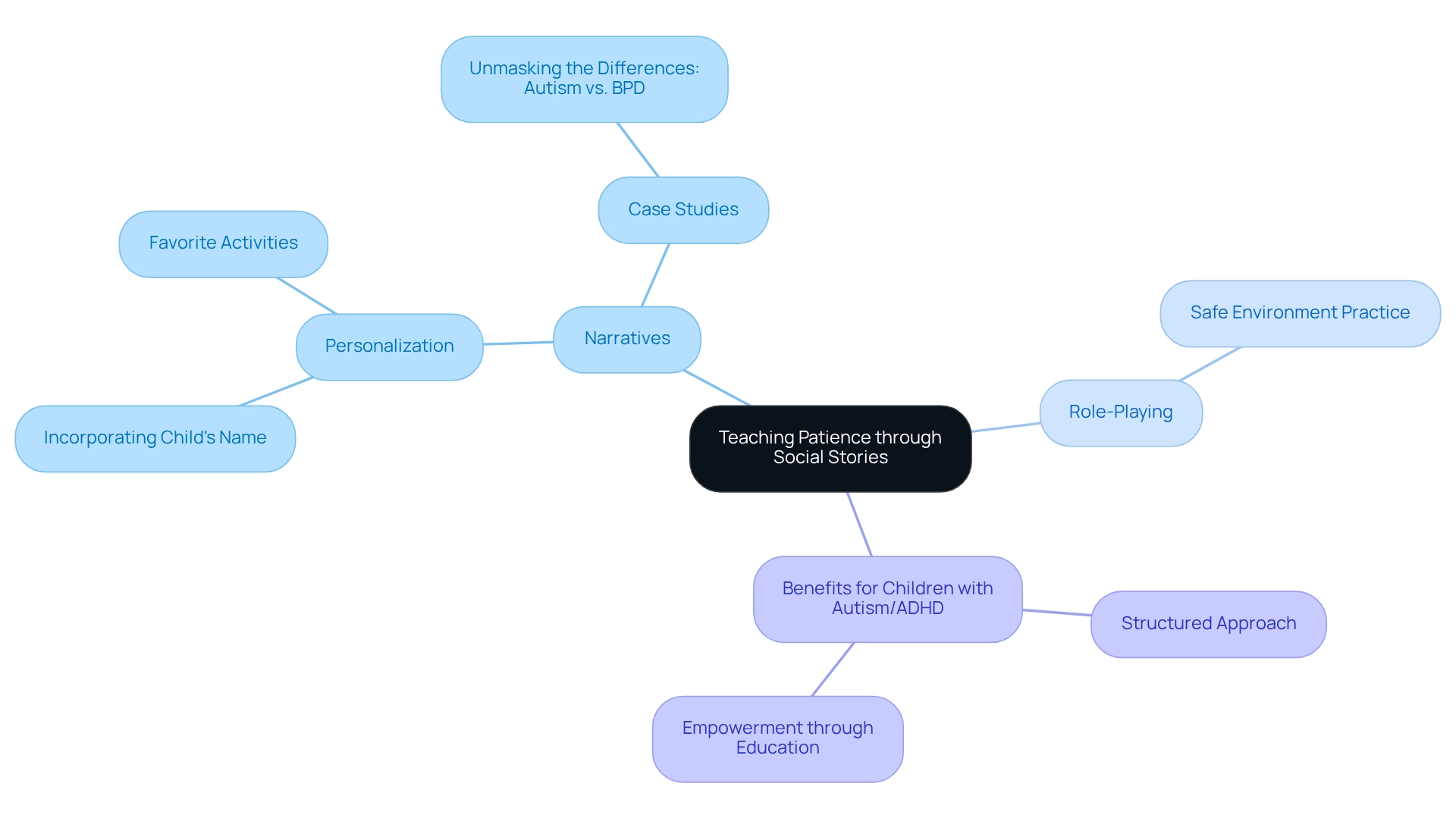
Role-Playing Turn-Taking Scenarios: Interactive Learning for Kids
Engaging in a taking turns social story through role-playing scenarios allows children to immerse themselves in interactive education, where they can act out situations that require waiting for their turn. Imagine children participating in a taking turns social story game where they take turns rolling a die or sharing a toy. This hands-on approach not only makes learning enjoyable but also cultivates essential skills like patience and communication within a nurturing environment. Caregivers play a pivotal role by offering constructive feedback during these activities, reinforcing positive behaviors and clarifying any misunderstandings.
Research indicates that such interactive methods significantly enhance educational outcomes for young individuals with autism, positioning role-playing as a valuable tool for developing social skills. A case study titled "Future Directions for Research in Educational Role-Play" emphasizes the necessity for more extensive studies on the effectiveness of role-play in education, highlighting existing research gaps that warrant exploration. Moreover, this inclusive educational approach fosters a sense of belonging among all students, which is crucial for their growth. Educators have noted that collaborative activities in classrooms lead to improved learning outcomes for all students involved, further supporting the notion that role-playing enhances educational results for individuals with autism. This comprehensive perspective underscores the importance of interactive methods in nurturing vital social skills.
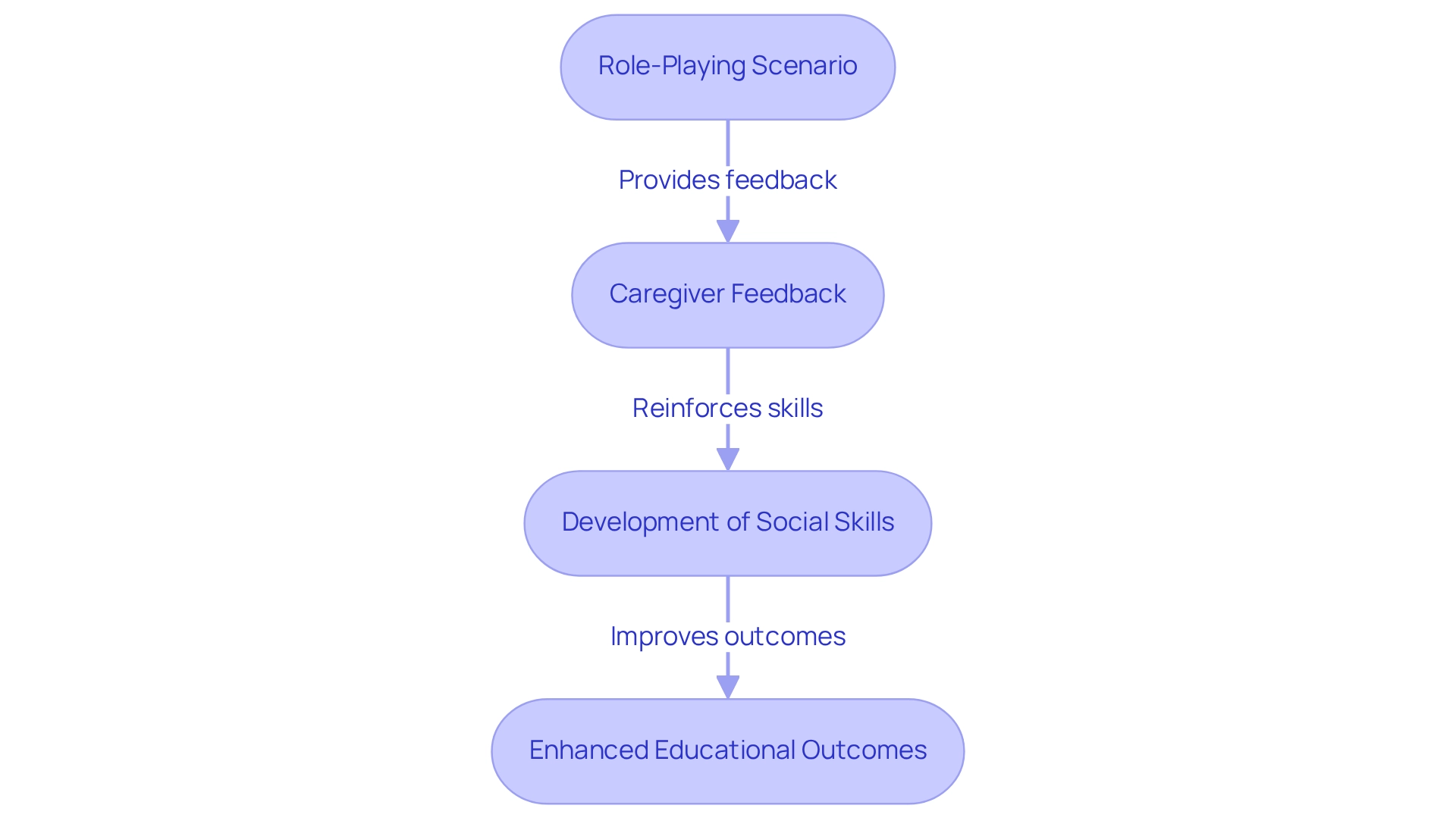
Visual Reinforcement Activities: Enhancing Understanding of Turn-Taking
Visual reinforcement activities are vital in teaching a taking turns social story, as they utilize charts or cards to illustrate the sequence of actions. Imagine a visual timetable that illustrates the taking turns social story by clearly showing who goes first, second, and so on; this can greatly assist youngsters in grasping the order of activities. Furthermore, incorporating tokens or stickers as rewards for successful turn-taking not only motivates young individuals but also reinforces their understanding of patience. This approach resonates with recent studies that highlight the effectiveness of visual aids in reducing anxiety and promoting independence among individuals with autism.
As Dr. Temple Grandin wisely stated, "The world needs different kinds of minds to work together," which underscores the importance of diverse learning strategies in ABA therapy. Similarly, Stephen Shore reminds us that "If you've met one person with autism, you've met one person with autism," emphasizing the need for personalized strategies tailored to each individual's unique requirements. A case study titled "Using Visual Aids" illustrates the effectiveness of these tools in supporting young learners, demonstrating that visual aids help individuals understand expectations and navigate daily tasks.
By providing tangible incentives and employing tailored visual aids, these methods create a supportive learning environment that encourages engagement and collaboration. Parents can take proactive steps at home by implementing specific strategies, such as creating personalized visual schedules or utilizing reward systems, to effectively teach patience and the concept of turn-taking using a taking turns social story. Your involvement can make a significant difference in your child's learning journey.
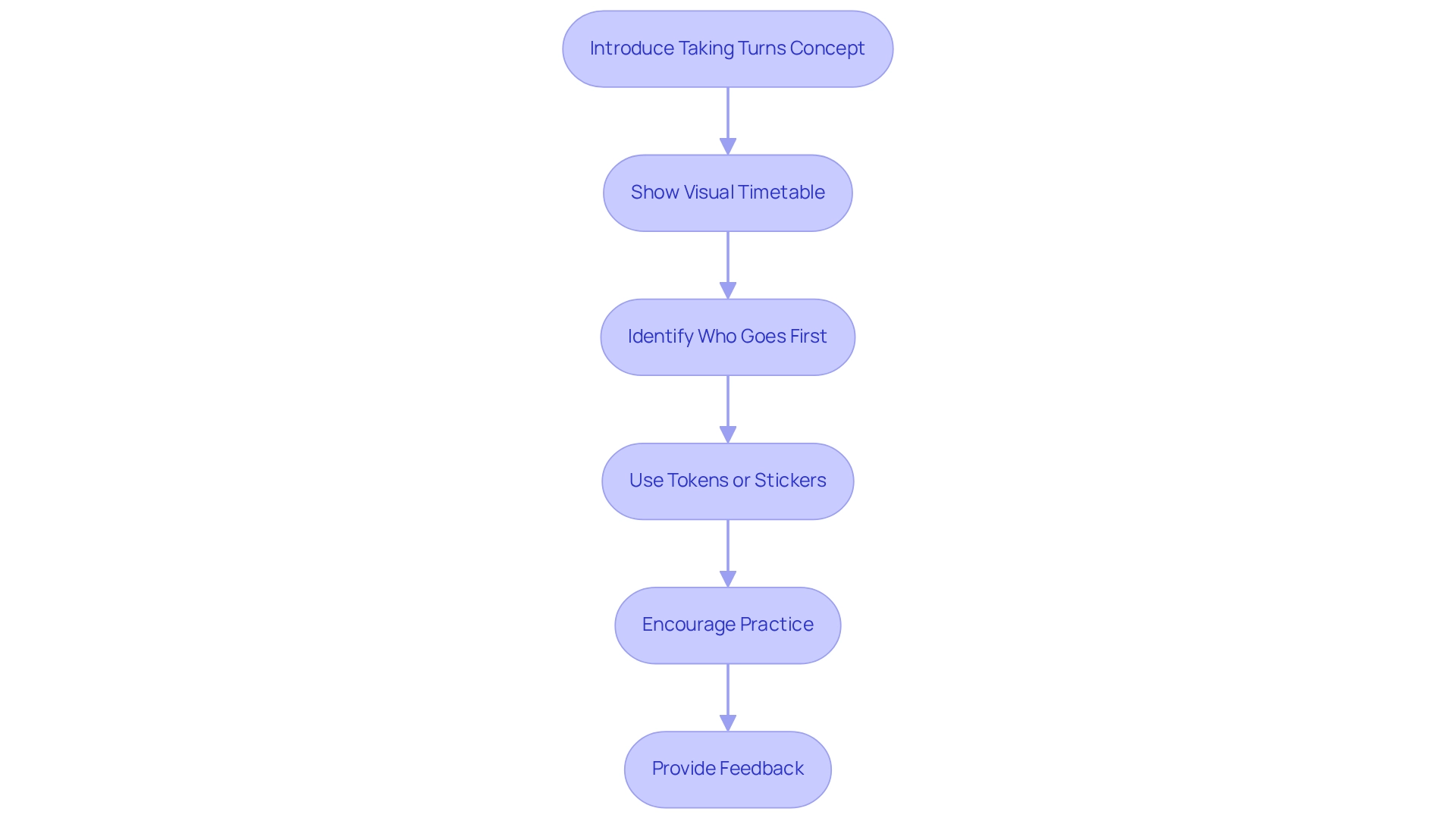
Wait for It: A Fun Timing Game to Teach Patience
The 'Wait for It' game is a delightful activity that invites children to practice patience while eagerly anticipating their turn to toss a ball or answer a question. This engaging waiting period opens up opportunities for youngsters to share what they are looking forward to next, transforming waiting into a moment of excitement rather than anxiety. As Helen Hayes wisely noted, "The expert in anything was once a beginner," reminding us that nurturing patience and social skills is a journey that unfolds over time. By incorporating a taking turns social story into daily routines, children can enhance their social skills, discovering the joy of waiting and turn-taking in a fun, interactive way.
Moreover, as Brian Herbert reminds us, learning serves as a powerful catalyst for personal growth. Structured activities like 'Wait for It' can significantly support this development. It's important to recognize that a study titled "90th Percentile Enrichment Time Analysis" highlights a concerning disparity: youths from high-income households engage in approximately four more hours of enrichment activities weekly compared to their middle- and low-income peers. This disparity underscores the advantages that wealthier families have in providing enriching opportunities.
By integrating a taking turns social story and timing games into their children's play, parents can help bridge this gap, ensuring that every child has the chance to cultivate essential skills like patience and turn-taking. Imagine the positive impact this could have on our children’s social interactions and emotional well-being! Let's work together to create a nurturing environment where all children can thrive.
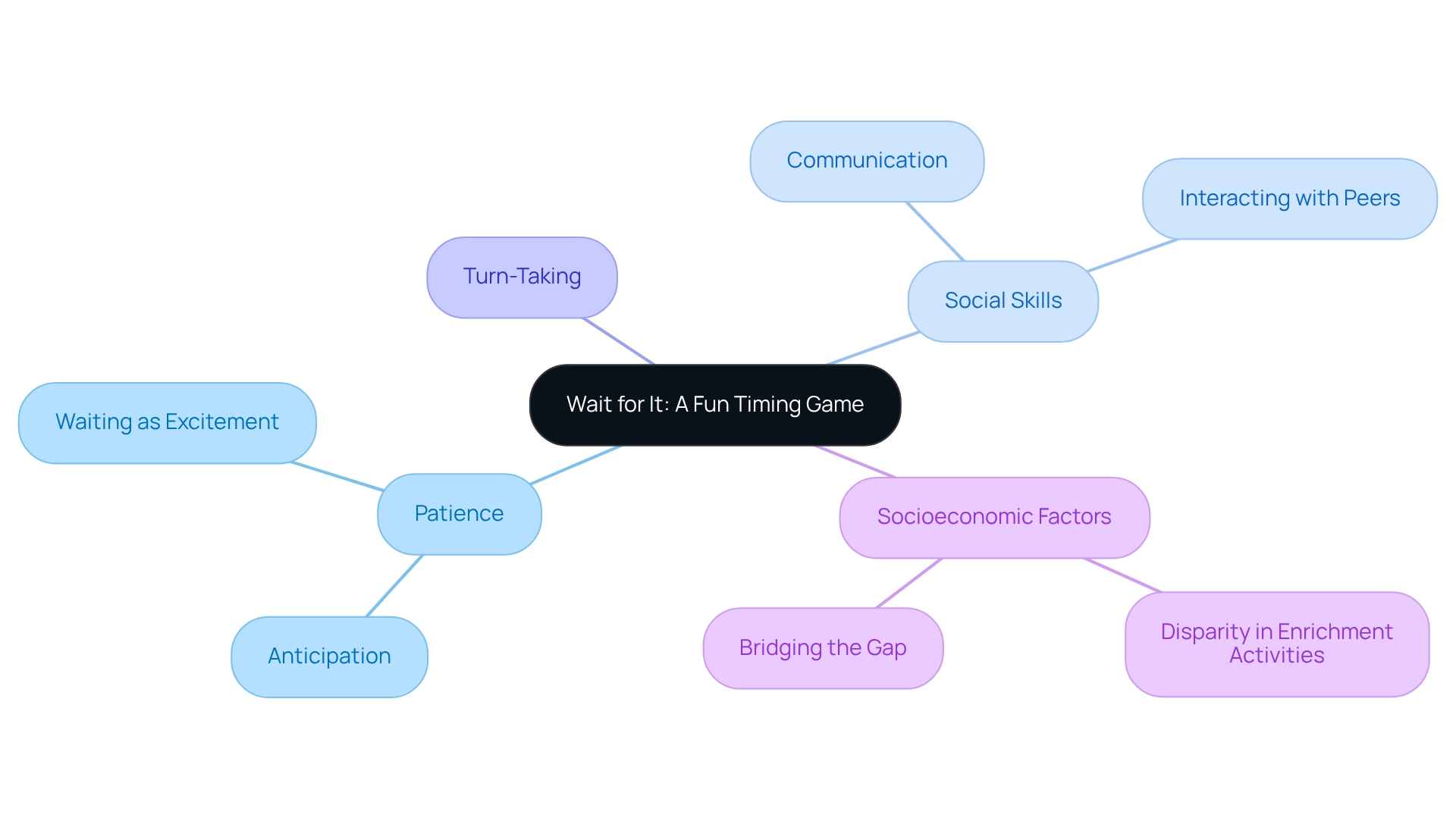
Storytelling with Personalized Scenarios: Making Social Skills Relatable
Customized storytelling is a powerful tool that creates narratives connecting with an individual's own experiences, making lessons not only relatable but also impactful. Imagine a story centered around a birthday party; it serves as a taking turns social story by beautifully illustrating the concept of waiting to open presents. By incorporating familiar environments and figures into these narratives, young people are more inclined to relate to the content, enhancing their understanding of interpersonal abilities. This approach not only makes learning about turn-taking more enjoyable through a taking turns social story, but also aids in the internalization of these vital skills.
Research shows that narrative methods significantly enhance the development of interpersonal abilities, as they allow youngsters to envision and rehearse actions in a context they understand. A compelling case study titled 'Adapting Case Studies for Large Classes' discusses effective strategies for implementing storytelling techniques, emphasizing the importance of group work and engagement, which can be particularly beneficial in various educational settings.
Moreover, statistics reveal that tailored storytelling can lead to a remarkable 30% boost in the retention of interpersonal skills among youngsters with autism. As we embrace advancements in artificial intelligence, we find new opportunities for personalized learning experiences, adapting social stories to meet individual needs and responses. One expert poignantly remarked, 'Social stories serve as a testament to the effectiveness of tailored interventions in addressing the specific challenges encountered by youngsters with autism.' This connection to technology not only highlights the evolving nature of autism support but also reinforces the effectiveness of personalized storytelling in education.
As we reflect on these insights, consider how you might incorporate storytelling into your approach to learning and support. Sharing your experiences can foster a community of understanding and growth.
What Would You Do? Discussion Cards for Turn-Taking Conversations
The 'What Would You Do?' Discussion cards offer a wonderful opportunity for young ones to explore various situations in a taking turns social story. Imagine a scenario where two friends both want the same toy. This not only sparks conversation about potential solutions but also highlights the importance of sharing. Engaging in this activity not only reinforces the principles outlined in the taking turns social story but also nurtures critical thinking and problem-solving skills. Research from Rasmussen University reveals that using open-ended questions during these discussions encourages deeper analysis and creative thinking in children, making it a valuable tool in autism therapy. Furthermore, scenario-based learning has been shown to enhance young people's ability to navigate social interactions, equipping them with essential skills for real-life situations.
As adults, we can demonstrate how to handle challenges and setbacks, allowing young individuals to witness effective problem-solving techniques in action. A case study titled 'Interactive Activities for Problem-Solving Development' highlights the effectiveness of reading, storytelling, and problem-solving worksheets as engaging methods to teach preschoolers essential problem-solving skills. These activities immerse children in critical thinking and decision-making, providing them with vital skills that will aid them in various life situations.
For parents and caregivers, incorporating discussion cards into daily conversations can be a practical way to reinforce these abilities at home. By sharing experiences and encouraging dialogue, we can support our children’s growth and development in a nurturing environment.
Patience Jar: A Visual Tool for Encouraging Turn-Taking
The Patience Jar serves as a powerful visual aid that supports turn-taking abilities in young children, effectively functioning as a taking turns social story. By allowing kids to place tokens or marbles into the jar each time they successfully wait for their turn, this approach not only reinforces the concept of patience but also provides a tangible representation of their progress. As the jar fills, children experience a sense of accomplishment that is crucial for their motivation and self-esteem.
Research indicates that visual aids like the Patience Jar can significantly enhance educational outcomes, particularly in the development of social skills. In 2022, it was noted that there were no increases in scores for any selected student groups at the 25th or 75th percentiles in both reading and mathematics. This highlights the pressing need for effective teaching tools, such as the Patience Jar, to support our children.
Moreover, the use of reward systems in ABA therapy has proven to effectively encourage positive behaviors, making the Patience Jar an excellent addition to any behavioral strategy. Successful implementations of patience jars have demonstrated their effectiveness in teaching the taking turns social story, underscoring the importance of visual aids in fostering patience and collaboration among children.
As Vince Gowmon wisely reflects, "The question then becomes: How well do you live with a broken heart?" This thought-provoking quote resonates deeply with the emotional facets of learning and patience, reminding us of the necessity for supportive resources in our children's developmental journeys. Additionally, early identification and intervention can greatly improve outcomes for children facing developmental challenges, making tools like the Patience Jar essential for their growth.
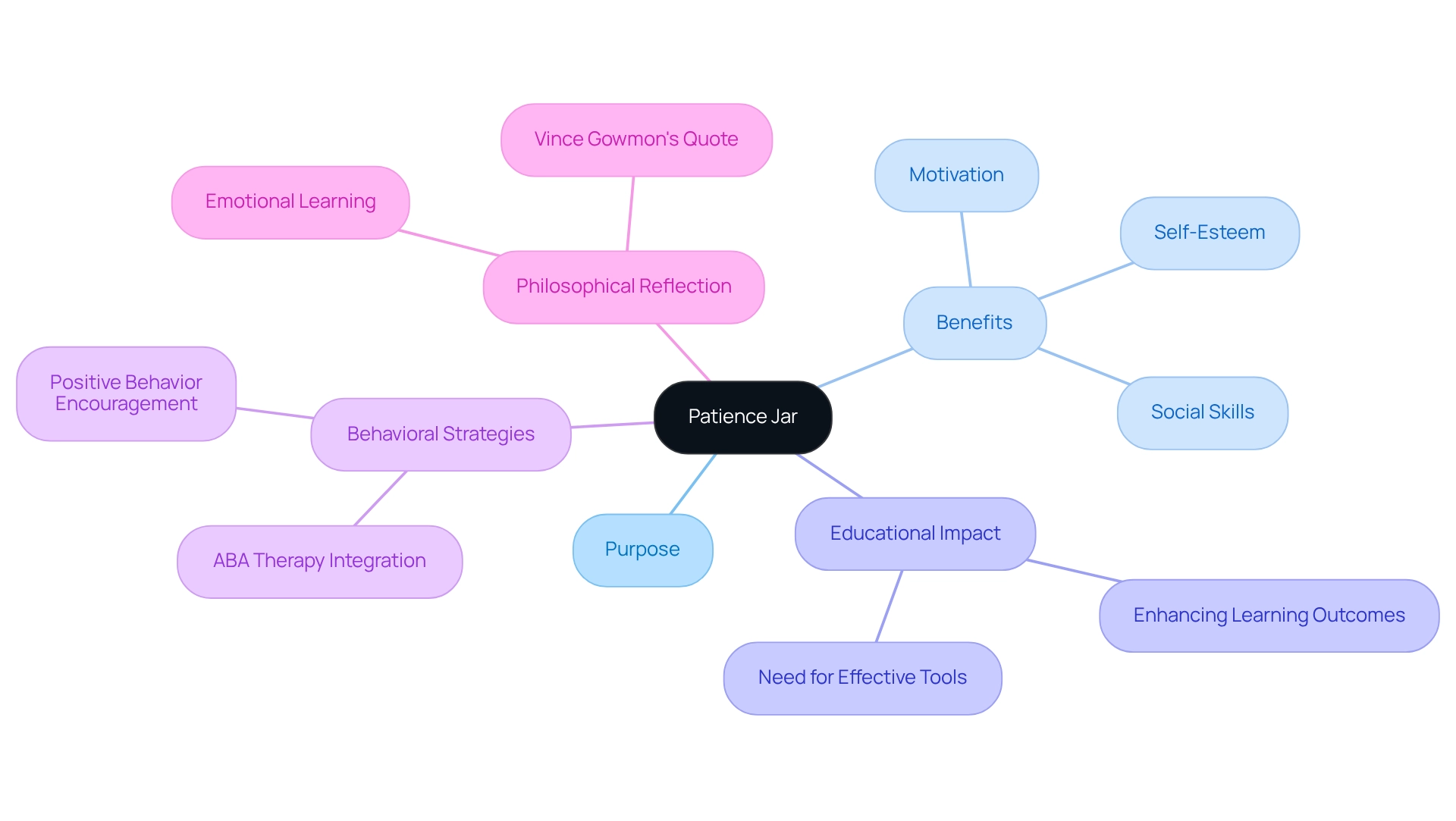
Sharing is Caring: A Social Story to Support Turn-Taking
The 'Sharing is Caring' narrative beautifully underscores the vital role of sharing in nurturing turn-taking abilities as highlighted in the taking turns social story. By showcasing scenarios where sharing fosters positive interactions, children can grasp the importance of patience and cooperation. Engaging with the taking turns social story together opens the door to meaningful discussions about personal experiences with sharing and turn-taking, effectively reinforcing the lesson.
Research illuminates that sharing is a cornerstone of interpersonal skills development. Studies reveal that young individuals involved in sharing activities demonstrate enhanced interactions. For instance, a study backed by the John Templeton Foundation and the National Science Foundation, involving 219 children aged three to five, highlighted the connection between sharing behaviors and positive peer relationships.
Moreover, expert insights suggest that narrative techniques serve as powerful tools for conveying these concepts, presenting relatable scenarios that children can easily understand. Furthermore, the case study titled 'The Importance of Developmental Readiness' emphasizes that parents should wait until their children are developmentally prepared to learn about sharing, rather than imposing the concept too early.
By integrating effective sharing activities into autism education, parents and educators can create an environment that nurtures these essential skills, ultimately enhancing children's social interactions and developmental readiness.
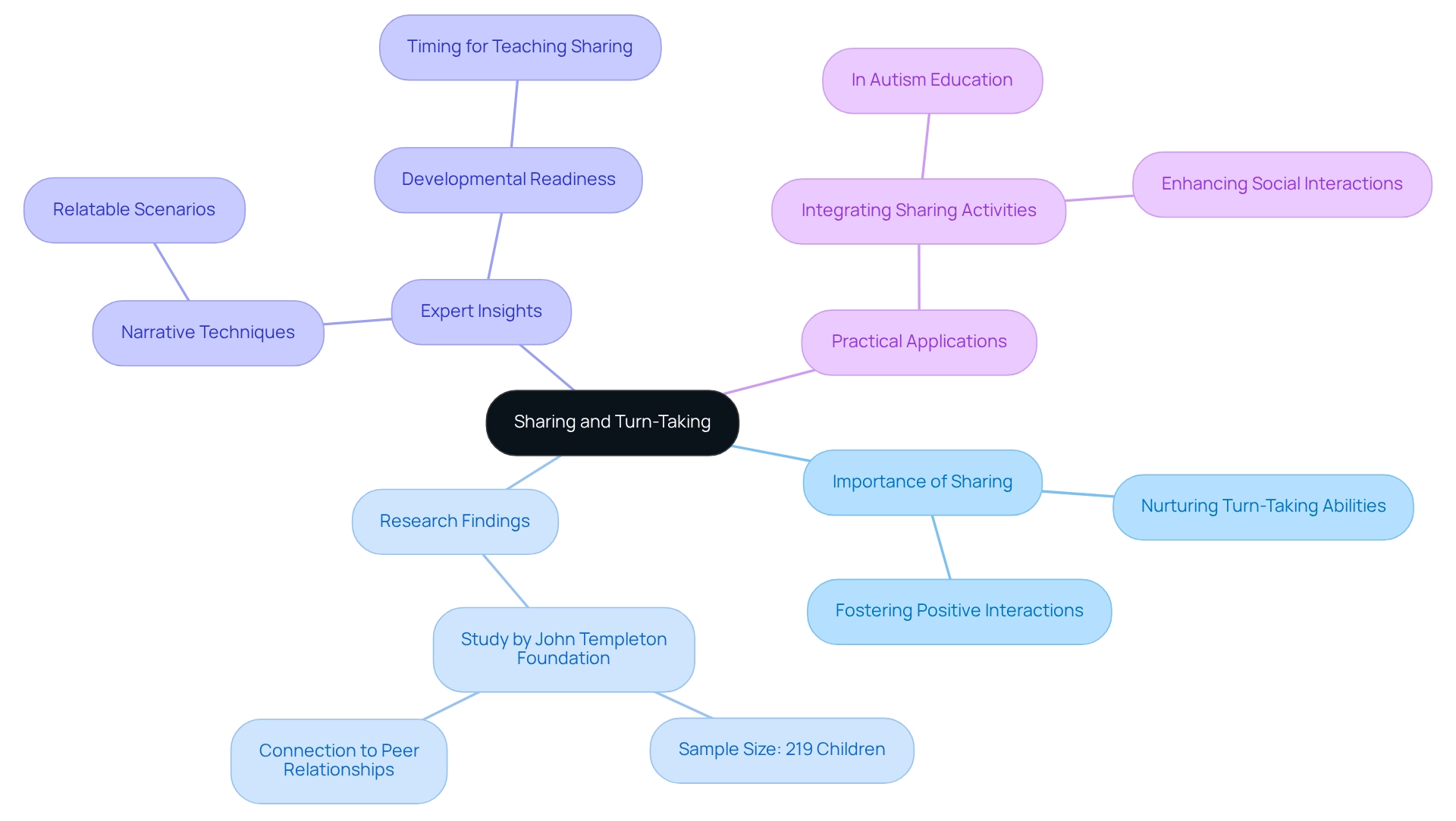
Interactive Activities: Reinforcing Turn-Taking Skills in Everyday Life
Integrating interactive activities that reinforce turn-taking skills into daily life, as described in the taking turns social story, is not only effective but also enjoyable for both children and parents. For instance, during mealtime, youngsters can take turns serving food or selecting dishes, which encourages a sense of shared responsibility among family members. Similarly, during playtime, a taking turns social story can help in alternating turns in games or activities, which enhances engagement and reinforces the concept of turn-taking. As Vince Gowmon, a passionate advocate for youth, poignantly asks, "The question then becomes: How well do you live with a broken heart?" This question highlights the emotional significance of interpersonal interactions, including the art of turn-taking.
Regular practice in various environments helps children absorb these skills, which makes the taking turns social story a natural part of their interactions. Research indicates that such daily activities significantly improve children's interpersonal abilities, fostering emotional regulation and empathy—qualities that are essential for nurturing healthy relationships. A case study titled "The Role of Play in Emotional Regulation" explores how play aids in emotional regulation and the development of empathy in young individuals, underscoring the importance of these abilities in interpersonal contexts.
Additionally, data reveal that each of the 27 Swiss playgroups had a median of 7 children, illustrating the communal atmosphere in which turn-taking abilities are practiced. This context reinforces the idea that play not only fosters social skills but also promotes the growth of executive functioning, making it vital for cultivating healthy interpersonal relationships.
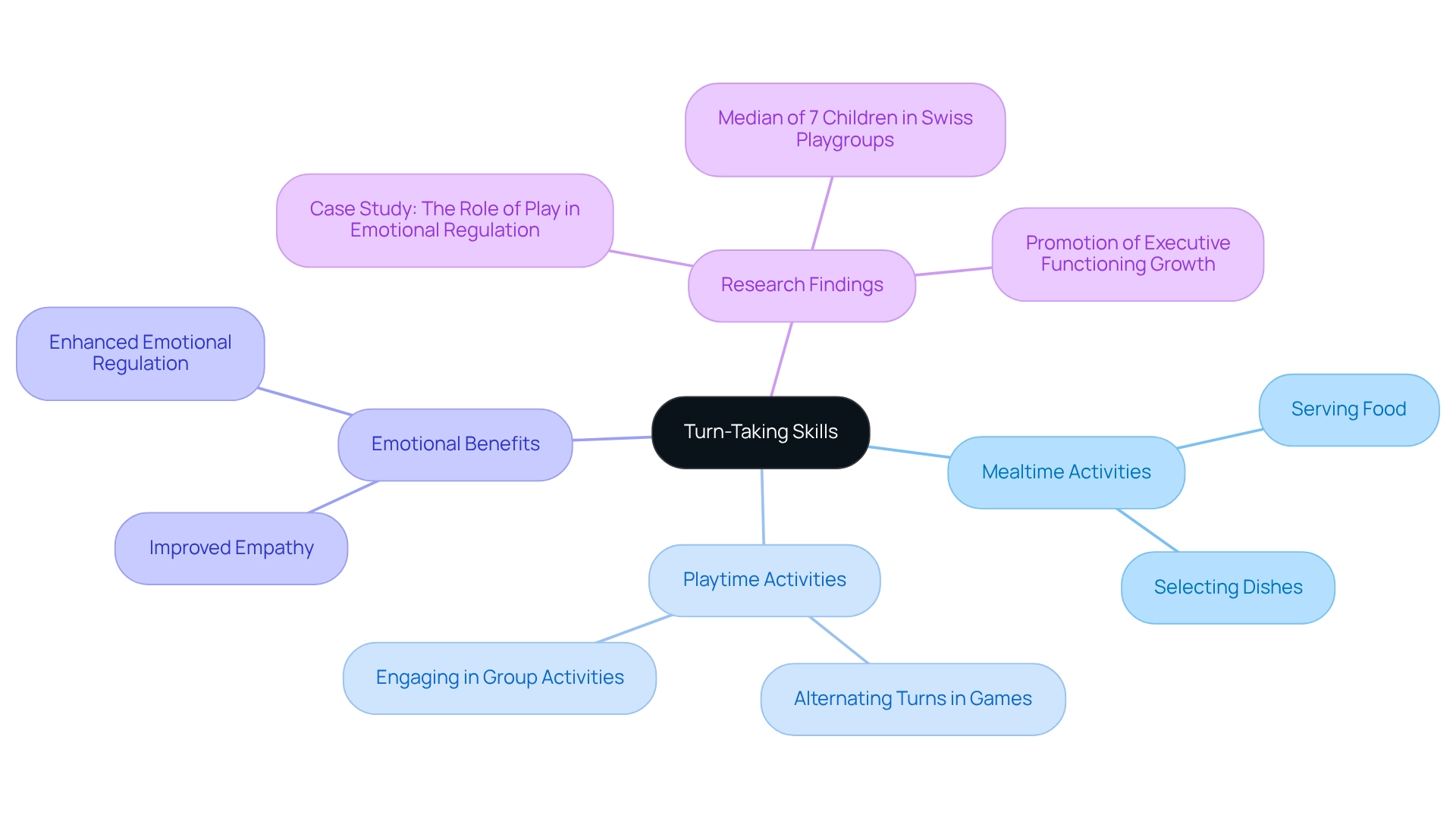
Conclusion
Innovative resources like those provided by ASD Media are transforming the way children with autism and ADHD develop essential social skills. By emphasizing community support and collaboration, ASD Media empowers parents and professionals with effective strategies that enhance social interactions. The integration of personalized storytelling, role-playing, and visual aids not only makes learning engaging but also significantly improves children's understanding of patience, turn-taking, and cooperation.
The evidence presented throughout this article highlights the effectiveness of these multifaceted approaches. From the use of social stories that make concepts relatable to interactive role-playing exercises that foster real-life skills, each method plays a crucial role in transforming challenging social situations into manageable learning experiences. Additionally, visual reinforcement tools like the Patience Jar and practical activities encourage children to internalize these skills in everyday contexts, further enriching their social development.
Ultimately, the commitment to personalized learning experiences and community involvement creates a supportive environment where children can thrive. By embracing these innovative resources, parents and educators can cultivate a brighter future for children facing social challenges, equipping them with the skills they need to navigate the world with confidence and ease. Together, these efforts foster not just individual growth but also a more inclusive society that values and understands the unique needs of every child.
Frequently Asked Questions
What is the mission of ASD Media?
ASD Media is dedicated to promoting the application of ABA therapy by providing resources to enhance interpersonal abilities. Their mission focuses on empowering parents and professionals with effective strategies and insights for individuals with autism and ADHD to improve their interactions.
How does community support impact ABA therapy outcomes?
Recent studies indicate that community support plays a critical role in ABA therapy, with collaborative efforts among therapists, families, and individuals leading to significantly improved therapeutic outcomes.
What challenges exist in measuring outcomes in ABA therapy?
There is an overall rate of missing information at 11.2% for analytic variables, which presents challenges in effectively measuring outcomes in ABA therapy. Health system implementation challenges can limit the translation of interventions into meaningful patient outcomes.
Can you provide an example of a successful strategy for social skills development?
One successful strategy highlighted is the "Waiting for My Turn" social story, which illustrates the importance of patience in various scenarios, such as waiting to play with a toy or contribute to a group discussion.
What findings were observed in a longitudinal study of children receiving ABA therapy?
The study showed that children who remained in ABA therapy for 24 months exhibited modest improvements in adaptive behavior scores, particularly among those with lower initial scores.
How does the "Waiting for My Turn" narrative help children?
This narrative helps children understand patience by illustrating various scenarios where waiting is essential. Personalizing the story with the child's name and favorite activities makes it more relatable and impactful.
What role do role-playing activities play in teaching patience?
Role-playing activities enhance the learning experience by allowing children to practice waiting scenarios in a safe environment, reinforcing their understanding of patience and social interactions.
How do social narratives benefit youth with autism and ADHD?
Social narratives educate and empower young individuals, transforming challenging interpersonal situations into manageable learning opportunities, and they aim to teach patience rather than control behavior.
What insights were gained from the case study "Unmasking the Differences: Autism vs. BPD"?
The study revealed overlapping traits between autism and borderline personality disorder, emphasizing the need for tailored management strategies to support youth's interpersonal growth.
How can parents and educators create tailored narratives for their children?
Parents and educators are encouraged to create personalized narratives that incorporate specific scenarios and characters relevant to the child, enhancing their understanding of patience and social interactions.




